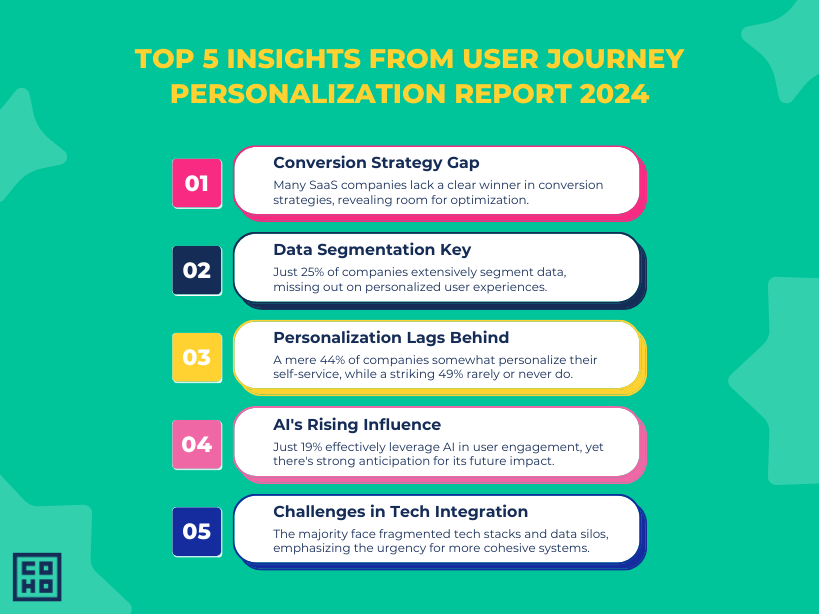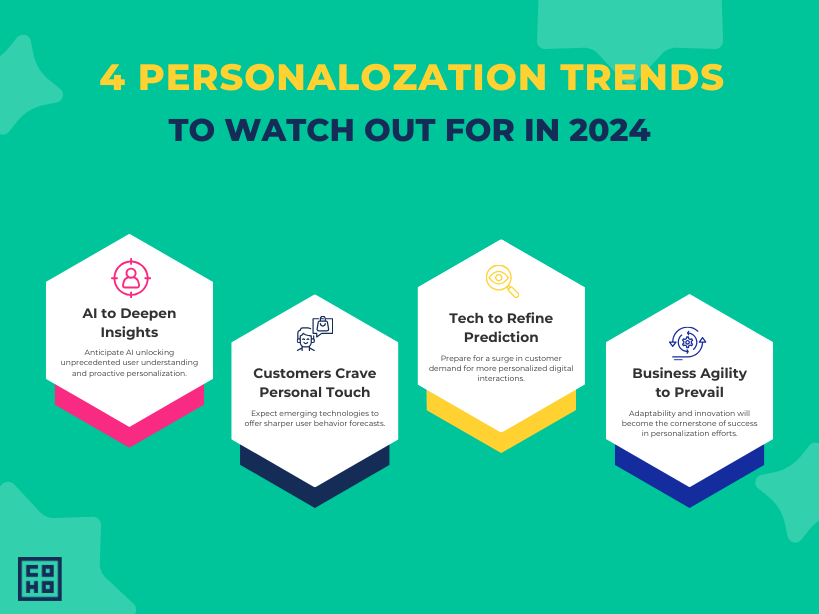Download the full “2024 State of User Journey Personalization” report.
The art of tailoring user experiences has become imperative as we move into 2024. Standing at the forefront of this business era, it guides companies towards achieving measurable success. “The 2024 State of User Journey Personalization” delves into this evolving field, uncovering the latest trends, challenges, and expert insights.
Beyond Trends: Crafting Resonating User Experiences
Personalization is so much more than a trending term in marketing. It involves a deep understanding of your users’ preferences, behaviors, and aspirations, and then creating experiences that resonate on a personal level. This is not solely about leveraging the latest tools in AI or data analytics. It’s about seamlessly integrating technology with a genuine, empathetic understanding of what users seek. Our investigation reveals how to achieve this delicate balance, blending technological advancements with human-centric approaches.
Overview of Current State in Digital Personalization
Providing a comprehensive overview of the current state in digital marketing personalization, the report becomes an indispensable resource for businesses. It offers insights into evolving trends, highlights challenges, and showcases emerging opportunities in user personalization. With a thorough analysis of industry practices, it shines a light on the methods companies are employing to navigate the complexities of digital engagement and evolving consumer behavior.
The Future of Digital Engagement
As we advance into the digital landscape of 2024 and beyond, understanding personalization becomes crucial. This exploration is not just about tactics; it’s about the essence of forming meaningful connections with users. We invite you to join us in discovering how to transform each digital interaction into a significant, human-centered experience.

Report Summary
Advancing Segmentation for Better User Insights
The digital marketing landscape is at a pivotal point, presenting significant opportunities for innovation, especially in personalization. Our report reveals a key insight: only 25% of companies are extensively leveraging data segmentation for personalization. This highlights a substantial untapped potential and indicates that many businesses have yet to fully embrace the power of personalized marketing strategies.
The limited use of data segmentation not only points to a gap in current marketing practices but also unveils immense possibilities for those ready to explore deeper into personalization. This finding suggests that while the importance of personalization is widely acknowledged, its practical application faces hurdles, including challenges in understanding effective strategies and overcoming resource limitations.
Moreover, there is a noteworthy opportunity for companies that prioritize enhancing their personalization efforts. By effectively utilizing detailed user data—such as behavioral patterns, preferences, and interaction history—alongside sophisticated segmentation techniques, businesses can craft more relevant and engaging user experiences. This approach not only has the potential to boost user engagement but could also lead to higher conversion rates.
Embracing these advanced personalization tactics could be transformative for businesses aiming to stand out and forge stronger customer connections. This area of digital marketing, rich with unexplored potential, offers a pathway for businesses to not just compete but to lead in creating compelling, personalized user journeys.
Depth of Personalization in User Experiences
A significant insight from our report is the varying degrees to which companies personalize user experiences. Many respondents indicated challenges in segmenting user data or a lack of resources and tools, leading to limited personalization. Specifically, only 44% of companies are customizing messages and offers to a certain extent, while 49% rarely tailor their messaging. Surprisingly, 7% do not personalize at all.
The primary data sources utilized for creating personalized self-service user experiences are customer service interactions and records (16%), purchase history and transaction data (15%), and user acquisition channels (15%). However, the least utilized source is user behavior and usage patterns (9%), which is particularly striking given that this type of data is highly indicative of how to optimize product experiences.
Furthermore, only 7% of respondents view expanding their personalized self-service user experiences as a top priority, with a majority considering it merely a “nice to have” or being neutral about it. This suggests a disconnect between user expectations and company priorities regarding personalization. Therefore, companies that focus on enhancing personalization, particularly through detailed user behavior data, advanced segmentation tools, and skilled personnel, are likely to gain a competitive edge. This focus is crucial for meeting evolving user expectations and optimizing user experiences.
AI Integration Challenges and Strategic Opportunities
The report illuminates a notable disparity in AI adoption for user engagement and conversion strategies. With just 19% of SaaS companies effectively leveraging AI, this scenario presents both a challenge and an opportunity in the digital marketing sphere. This gap is indicative of a broader trend where companies exhibit cautiousness in embracing AI, often due to the complexities associated with integrating it into their existing tech stacks.
The integration of AI into a company’s technology infrastructure is a critical factor in its effective adoption. Many businesses face hurdles in aligning AI capabilities with their existing tech stack, which can range from software compatibility issues to challenges in data integration and management. This often results in a reluctance or slower pace in adopting AI, despite recognizing its potential benefits.
However, this landscape is also ripe with opportunities for innovation and growth. The expectation that AI will play a more significant role in the future points to an evolving digital marketing environment. Companies that successfully integrate AI into their tech stack and strategies could set new benchmarks in user experience. By overcoming the initial challenges of AI adoption and tech stack integration, businesses can unlock new levels of efficiency, personalized engagement, and data-driven decision-making.
The early adopters of AI who navigate these complexities stand to gain a significant competitive edge. They can leverage AI not only for enhanced user engagement but also for more insightful data analysis, better prediction of user behavior, and more efficient operational processes. As AI continues to develop and become more accessible, its role as a game-changer in digital personalization becomes increasingly clear. Companies that are proactive in adapting their tech stack and strategies to incorporate AI effectively are likely to be at the forefront of the next wave of digital marketing innovation.
Best Practices and Strategies
The report’s findings highlight significant room for growth in the personalization of user experiences. With only a minority of companies extensively personalizing their self-service experiences, it becomes clear that many are still figuring out how to best utilize user data and segmentation tools. This underutilization not only signals a gap in current practices but also points to immense opportunities for those ready to dive deeper into personalization.
Effective personalization strategies go beyond surface-level customization. They require a nuanced understanding of user data to create truly individualized experiences. The report suggests that a strategic approach should include creating comprehensive user profiles using granular data. However, a key challenge identified is the integration of this data. The findings reveal that 72% of respondents are only partially integrating their go-to-market platforms with product usage data, and 26% are barely integrating it. This lack of full integration could lead to inaccuracies in the data used for personalization, resulting in messaging that is conflicting, repetitive, irrelevant, or untimely.
For companies to effectively personalize their user experiences, it is crucial to not only collect and analyze data but also to ensure its consolidation across various platforms and departments. Breaking down data silos within the organization and achieving a unified view of customer data is fundamental. This integration enables businesses to respond more effectively and timely to user needs, thereby enhancing the overall user experience. Companies that successfully navigate these complexities and leverage their data strategically are set to lead in the evolving landscape of digital personalization.

Looking Forward at 2024: Predicted Trends
The Evolution of AI in Personalization
The next few years are set to bring a significant shift in personalization, primarily driven by advancements in AI. Moving beyond traditional analytics, AI-driven approaches are paving the way for hyper-personalization. This evolution promises a deeper and more intuitive understanding of user preferences. Our report delves into how technologies like deep learning and natural language processing are redefining customer interactions, allowing businesses to offer hyper-personalized experiences with unprecedented accuracy and impact.
Emerging Technologies and Their Impact
Emerging technologies, especially machine learning algorithms and predictive analytics, are poised to revolutionize the personalization landscape, placing micro-segmentation marketing at its core. These advanced tools enable more precise predictions of user behavior, leading to highly effective and engaging user journeys. The report explores the integration of these technologies in various user journey strategies, highlighting their potential to enhance micro-segmentation for content customization and predictive customer service.
Changing Customer Expectations
As 2024 approaches, costumer expectations for personalized experiences are soaring. Tech-savvy consumers are increasingly demanding bespoke experiences, pushing the boundaries of personalization. Our report analyzes these evolving consumer behavior trends, emphasizing the growing need for seamless, hyper-personalized interactions across digital platforms. Businesses are encouraged to be agile and innovative to align with these shifting expectations.
Strategic Adaptations for Businesses
Personalization is a fast-evolving field that requires businesses to adapt as well as lead. Embracing new technologies, understanding shifting consumer behaviors, and cultivating a culture of continuous learning and innovation is essential. Investing in new technologies and cultivating a workforce that is agile, tech-savvy, and customer-centric are among the steps businesses can take to make these strategic shifts proactively.
Don’t miss the opportunity to lead in the personalization revolution. Download the full “2024 State of User Journey Personalization” report for an in-depth understanding of these upcoming trends and strategies. Stay ahead of the curve and equip your business for success in 2024 and beyond.


